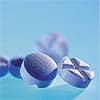
What's Hot
What's Hot
News flashes are posted here frequently to keep you up-to-date with the latest advances in health and longevity. We have an unparalleled track record of breaking stories about life extension advances.
Oxidized plasma cysteine linked with inflammation
Emory School of Medicine professor Dean P. Jones, PhD and colleagues investigated the relationship of plasma oxidized cysteine to levels of interleukin-1 beta, a proinflammatory cytokine. Cysteine is an amino acid which has an antioxidant effect in its reduced state in the body, but can become oxidized under conditions of extracellular oxidative stress, such as smoking, alcohol consumption, illness, and malnutrition. Oxidized cysteine levels in the blood have been demonstrated to rise with age. "Our research shows a direct mechanistic link between the oxidative stress biomarker (cysteine redox potential) and proinflammatory cytokines, which have been linked to multiple age-related and chronic diseases," Dr Jones stated. "Our group and others have already established that cysteine redox potential is oxidized with aging and with a number of health risk factors. This suggests that one could target cysteine redox potential as a means to decrease chronic proinflammatory signaling as an intervention for age-related diseases and for the acute inflammation of sepsis or lung injury." When asked about the potential impact effect of orally ingested oxidized cysteine, Dr Jones informed Life Extension that consuming oxidized cysteine is not believed to negatively affect the balance in the blood, due a mechanism that occurs during digestion that exchanges the oxidized form for the reduced form in the intestines. “However, if that capability in the intestines declined with age or disease, then the dietary form would be expected to be an important determinant of the blood cysteine redox balance,” he noted. The authors note that “Supplementation with cysteine or cysteine precursors during early sepsis may be a strategy to alleviate acute inflammation and associated tissue injury.” —D Dye Higher selenium levels and folate intake associated with lower risk of colon cancer
The current study included 620 subjects with cancer and 1,007 individuals without the disease who participated in the North Carolina Colon Cancer Study, a case-control study of colon cancer in North Carolina between 1996 and 2000. Dietary questionnaire responses were analyzed for nutrient content, including folate, and stored serum samples were analyzed for selenium levels. The researchers found that participants with selenium levels of 140 micrograms per liter or higher combined with an intake of folate that was at least 354 micrograms per day had half the risk of colon cancer than those with lower levels of both nutrients. Subjects with high serum selenium and low folate, low selenium and high folate, and low selenium and low folate experienced similar colon cancer risks. Separate analysis according to cancer stage produced similar results. Although numerous studies have found protective benefits for either nutrient against cancer, the authors note that no other epidemiological studies have analyzed the interaction between folate and selenium in colon cancer risk. Deficiencies in either nutrient result in global DNA hypomethylation, which increases the risk of cancer. Additionally, folate and selenium have been reported to enhance an aspect of immune function, which could also help protect against the disease. “Our findings suggest that it is important to take folate status into account when evaluating the relation between selenium and colon cancer in future studies,” the authors conclude. —D Dye L-carnitine supplementation protects against liver cancer in animal model
For the current research, King Saud College of Pharmacy Professor Mohamed M. Sayed-Ahmed and colleagues supplemented 20 rats with L-carnitine, and 20 rats with D-carnitine and mildronate to induce carnitine deficiency, daily for 8 weeks. After two weeks of supplementation, ten rats in each group plus 10 nonsupplemented rats received an injection of the carcinogen diethylnitrosamine (DENA) followed by a dose of carbon tetrachloride following another two weeks. Ten unsupplemented control rats were injected with normal saline. At the end of the treatment period, increased liver enzymes, liver degeneration, and precancerous liver lesions were observed among the DENA-treated unsupplemented and carnitine deficient groups. These changes were prevented in DENA-treated animals that were supplemented with L-carnitine. While DENA administration resulted in increased oxidative stress and a reduction in glutathione and antioxidant enzymes in the livers of unsupplemented and carnitine-deficient mice, the effect was modified by L-carnitine. “In conclusion, data from this study suggest for the first time that: (1) carnitine deficiency is a risk factor and should be viewed as a mechanism in DENA-induced hepatic carcinogenesis; (2) oxidative stress plays an important role but is not the main cause of DENA-related hepatic carcinogenesis; and (3) long-term L-carnitine supplementation prevents the development of DENA-induced liver cancer,” the authors write. “Therefore, carnitine supplementation alone or in combination with other natural chemopreventive compounds could be used to prevent, slow or reverse the occurrence of liver cancer.” —D Dye Average vitamin D levels declining
Adit A. Ginde, MD, MPH of the University of Colorado Denver School of Medicine in Aurora and associates compared serum 25-hydroxyvitamin D levels from 18,883 participants in the Third National Health and Nutrition Examination Survey (NHANES), conducted from 1988 to 1994, with levels from 13,369 participants in NHANES 2001-2004. They found that the average vitamin D level of 30 nanograms per milliliter observed in the Third NHANES population dropped to 24 nanograms per milliliter in the NHANES 2001-2004 population. The percentage of those with levels below 10 nanograms per milliliter increased from 2 to 6 percent, and those with levels above 30 nanograms per milliliter, an amount that is considered by some authorities to be the minimum for optimal health, decreased from 45 to 23 percent. “Vitamin D insufficiency has been associated with increases in cardiovascular disease, cancer, and infection,” the authors observe in their introduction to the article. “Vitamin D supplementation appears to mitigate the incidence and adverse outcomes of these diseases and may reduce all-cause mortality.” Nevertheless, current recommended levels for supplementation reflect a focus on bone health rather than overall optimal health, and ignore the growing incidence of vitamin D insufficiency. "Increased intake of vitamin D (1,000 international units per day or more)—particularly during the winter months and at higher latitudes—and judicious sun exposure would improve vitamin D status and likely improve the overall health of the U.S. population,” the authors conclude. “Large randomized controlled trials of these higher doses of vitamin D supplementation are needed to evaluate their effect on general health and mortality." —D Dye Increased magnesium and calcium intake linked with lower diabetes risk
For the current investigation, researchers at Vanderbilt University and Shanghai Cancer Institute evaluated data from 64,191 participants in the Shanghai Women's Health Study, which included women aged 40 to 70 living in Shanghai, China. Surveys conducted at the beginning of the study and at the first biennial follow-up interview collected information on dietary intake and other factors. Over the 6.9 year follow-up period, 2,270 reported cases of diabetes were confirmed. Analysis of dietary questionnaire responses determined calcium and magnesium intake. For those whose intake was among the highest 20 percent at a median of 649.6 milligrams per day, a 27 percent lower risk of diabetes was observed compared with those whose intake was among the lowest fifth at 277.5 milligrams. Magnesium was also associated with a protective effect. Subjects whose intake of magnesium was highest at a median of 318.1 milligrams per day experienced a 20 percent average lower risk compared with those in the lowest category. Calcium and magnesium from milk sources appeared to be more protective than plant sources. Although they did not have information on the vitamin D intake of the participants, the authors remarked that the protective effect associated with dairy products could be due to their vitamin D as well as its calcium content. Vitamin D combined with calcium has been shown to be associated with a reduction in the risk of type 2 diabetes in previous research. "Our findings support the hypothesis that calcium and magnesium play a protective role in the development of type 2 diabetes," the authors conclude. —D Dye Teens get a “D” in vitamin D
"These are alarming findings,” noted lead author Sandy Saintonge, MD, who is an assistant professor of clinical pediatrics at Weill Cornell Medical College. “We need to do a better job of educating the public on the importance of vitamin D, and the best ways to get it. To meet minimum nutritional requirements teens would need to consume at least four glasses of fortified milk daily or its dietary equivalent. Other foods rich in vitamin D include salmon, tuna, eggs and fortified cereals. A vitamin supplement containing 400 IU of vitamin D is another alternative. We should also consider a national fortification strategy, perhaps including routine supplementation and monitoring of serum levels, but more research is needed to determine optimal vitamin D levels." Another finding of the study was a two times greater risk of deficiency among overweight teens compared to those who were of normal weight. "Because vitamin D is stored in body fat, simply increasing the dosage of vitamin D may not be effective in overweight adolescents," stated senior author Dr. Linda M. Gerber. "As the prevalence of childhood obesity increases, vitamin D deficiency may increase as well. In this group, appropriate nutrition could solve both problems." —D Dye Aspirin use among women with stable heart disease associated with better survival
The current analysis sought to evaluate the relationship between aspirin dose and clinical outcomes in 8,928 postmenopausal WHI participants with stable heart disease. Forty-six percent of the women reported using aspirin, of whom 70 percent used 325 milligrams and 30 percent used 81 milligrams per day. Myocardial infarction, stroke, and cardiovascular and all-cause mortality were tracked over an average 6.5 years of follow-up. The research team found a 25 percent lower risk of dying from heart disease and a 14 lower adjusted risk of dying from all causes in regular aspirin users, with no significant differences observed between aspirin doses. Women in their seventies were the only group who experienced an aspirin-associated reduction in heart attack or stroke. The finding is good news for women who are concerned about long term bleeding risks associated with use of higher aspirin doses, since low dose aspirin appeared as effective as a standard dose in this study. The bad news is that 54 percent of the participants were not using aspirin, even though its apparent ability to help protect against cardiovascular events in heart disease patients has been well publicized. “Aspirin use was associated with significantly lower risk of all-cause mortality, specifically, cardiovascular mortality, among postmenopausal women with stable cardiovascular disease,” the authors conclude. “Overall, aspirin use was low in this cohort of women. “ —D Dye Teens need more vitamin D
Johns Hopkins Bloomberg School of Public Health post-doctoral research fellow Jared P. Reis, PhD, and colleagues analyzed data from 3,577 boys and girls aged 12 to 19 who were participants in the National Health and Nutrition Examination Survey (NHANES). The team found that subjects whose blood levels of 25-hydroxyvitamin D were among the lowest 25 percent of participants had a 2.36 times greater adjusted risk of high blood pressure, and a 2.54 times greater risk of elevated blood sugar than those whose levels were in the highest 25 percent. Metabolic syndrome risk was 3.99 times greater in those whose vitamin D levels were low. The study also found that Mexican American and African American teens had lower levels of vitamin D than Caucasians. While Caucasian teens had average vitamin D levels of 24.8 nanograms per milliliter, levels of the vitamin in Mexican and African Americans averaged 21.5 and 15.5 nanograms per milliliter. "We showed strong associations between low levels of vitamin D and higher risk of high blood pressure, hyperglycemia and metabolic syndrome among adolescents, confirming the results of studies among adults," Dr Reis concluded. "This is an exciting time; since we are just now beginning to understand the role that vitamin D may play in cardiovascular health." —D Dye Green tea helps protect gums
"It has been long speculated that green tea possesses a host of health benefits," Dr Shimazaki observed. “And since many of us enjoy green tea on a regular basis, my colleagues and I were eager to investigate the impact of green tea consumption on periodontal health, especially considering the escalating emphasis on the connection between periodontal health and overall health." The study included 940 Japanese men aged 49 to 59. Self-administered questionnaires obtained information on daily green tea intake, toothbrushing habits, and other factors. Periodontal disease was evaluated during oral examinations which assessed probing depth, bleeding on probing, and clinical attachment loss. For each cup of green tea consumed by the participants, a decrease in all three indicators of periodontal disease was observed. The apparent protective effect of the drink on the gums observed in the study may be due to antioxidants in green tea known as catechins, which help reduce the mouth’s inflammatory response to periodontal bacteria. "Periodontists believe that maintaining healthy gums is absolutely critical to maintaining a healthy body," noted Dr David Cochran, DDS, PhD, who is the President of the American Academy of Periodontology. "That is why it is so important to find simple ways to boost periodontal health, such as regularly drinking green tea – something already known to possess certain health-related benefits." —D Dye B vitamin supplement use associated with lower homocysteine levels in celiac disease patients
Dr Muhammed Hadithi of VUmc University Medical Center and his associates measured vitamin B6, folate, vitamin B12, and homocysteine in 51 men and women with celiac disease, and 50 healthy age and gender-matched volunteers. They found that celiac disease patients who supplemented with these vitamins had higher serum vitamin levels and lower plasma homocysteine than nonusers of the supplements or healthy subjects. Vitamin B6 and folate levels were independently associated with homocysteine levels. Higher homocysteine levels were found to be correlated with villous atrophy. “The study demonstrated that patients with celiac disease using B vitamin supplements had lower total homocysteine levels than those who did not use B vitamin supplements,” the authors write. “Second, even if villous atrophy persists, B vitamin supplements can normalize B6, folate, B12 status and homocysteine levels. Finally, both the presence and the severity of celiac disease were determinants of total homocysteine levels, independent of measured B vitamin status.” —D Dye Selenium added to broccoli compound combats melanoma
Previous research conducted by Penn State associate professor of pharmacology, pathology and dermatology Gavin Robertson and his colleagues found that isothiocyanates target a protein known as Akt3 which is increased in approximately 70 percent of tumors. Recognizing that the known cancer fighting ability of isothiocyanates would require the administration of impractical amounts of the compounds, the team replaced isothiocyanantes’ sulfur bonds with selenium to create new compounds called isoselenocyanates. "Selenium deficiency is common in cancer patients, including those diagnosed with metastatic melanoma," explained Robertson. "Besides, selenium is known to destabilize Akt proteins in prostate cancer cells." When mice injected with melanoma cells were treated with isothiocyanates or isoselenocyanates, animals that received the selenium-containing compound had approximately 60 percent less tumor development compared with those that received isothiocyanates. In additional experiments with human melanoma cell lines, tumor growth was decreased by 30 to 70 percent. "We found that the selenium-enhanced compounds significantly reduced the production of Akt3 protein and shut down its signaling network," Dr Robertson stated. "There are currently no drugs to target the proteins that trigger melanoma," Dr Robertson noted. "We have developed drugs from naturally occurring compounds that can inhibit the growth of tumors in mice by 50 to 60 percent with a very low dose." "We have harnessed something found in nature to target melanoma," he remarked. "And since we only need tiny amounts to kill the cancer cells, it means even less toxic side-effects for the patient." —D Dye Vitamin B12 deficiency in pregnant women increases neural tube defect risk
Researchers at the National Institutes of Health, Trinity College Dublin, and the Health Research Board of Ireland analyzed stored blood samples collected from Irish women during early pregnancy between 1983 and 1990, when the use of nutritional supplements was uncommon. One hundred seventy-one women who were pregnant with a child having a neural tube defect at the time the blood was drawn and 107 women who had previously given birth to a child with a neural tube defect were compared with women whose pregnancies were not affected by the condition. It was discovered that women who had the lowest vitamin B12 levels had 5 times the risk of having a child with a neural tube defect than women with the highest levels. The authors note that vitamin B12 and folate are involved with DNA synthesis, which, if disrupted, could increase the risk of the condition. "Vitamin B12 is essential for the functioning of the nervous system and for the production of red blood cells," stated Duane Alexander, MD, who is the director of the NIH’s Eunice Kennedy Shriver National Institute of Child Health and Human Development. "The results of this study suggest that women with low levels of B12 not only may risk health problems of their own, but also may increase the chance that their children may be born with a serious birth defect." —D Dye
|

 An article published on March 27, 2009 in the journal
An article published on March 27, 2009 in the journal  In an article published in the most recent issue of the journal
In an article published in the most recent issue of the journal  On March 21, 2009, the
On March 21, 2009, the  In the March 23, 2009 issue of
In the March 23, 2009 issue of  A report published in the March, 2009 issue of the
A report published in the March, 2009 issue of the  In the March, 2009 issue of the journal
In the March, 2009 issue of the journal  An article published online on March 5, 2009 in the American Heart Association journal
An article published online on March 5, 2009 in the American Heart Association journal  Research reported on March 11, 2009 at the American Heart Association's 49th Annual Conference on Cardiovascular Disease Epidemiology and Prevention, held in Palm Harbor, Florida, revealed an association between reduced levels of vitamin D and a greater risk of hypertension, high blood sugar, and metabolic syndrome in teens. Metabolic syndrome is characterized by increases in waist circumference, blood pressure, serum triglycerides and blood glucose, and/or a decrease in high density lipoprotein cholesterol. Having several of these factors places one at a greater risk of developing heart disease or
Research reported on March 11, 2009 at the American Heart Association's 49th Annual Conference on Cardiovascular Disease Epidemiology and Prevention, held in Palm Harbor, Florida, revealed an association between reduced levels of vitamin D and a greater risk of hypertension, high blood sugar, and metabolic syndrome in teens. Metabolic syndrome is characterized by increases in waist circumference, blood pressure, serum triglycerides and blood glucose, and/or a decrease in high density lipoprotein cholesterol. Having several of these factors places one at a greater risk of developing heart disease or  In the March, 2009
In the March, 2009  The February 28, 2008 issue of the
The February 28, 2008 issue of the  In an article published in the March, 2009 issue of the journal
In an article published in the March, 2009 issue of the journal  A study described in the March, 2009 issue of the journal
A study described in the March, 2009 issue of the journal 